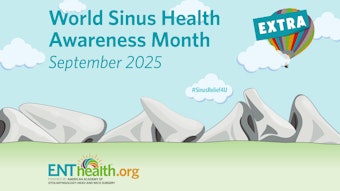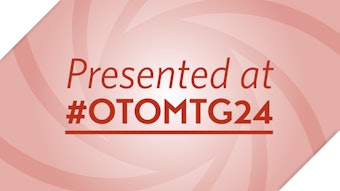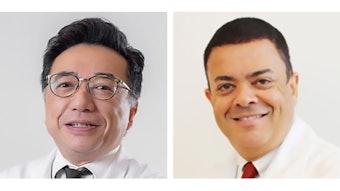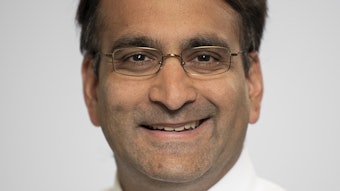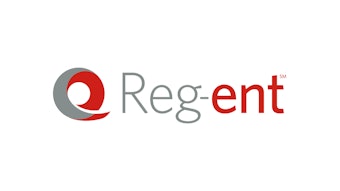The Current State of Radiofrequency Ablation (RFA) in Thyroid Nodules
Using RFA to expand indications, quality of life outcomes, and reimbursement models.
Julia E. Noel, MD, and Ameya A. Asarkar, MD
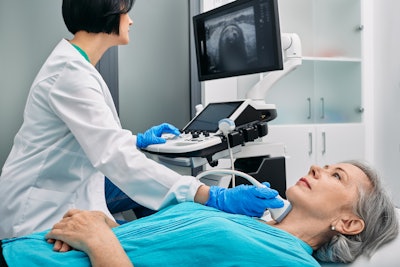
What Are the Current Indications for RFA in Thyroid Nodules?
All guidelines support the role of RFA in thyroid nodules confirmed benign with two biopsies, or one biopsy and a definitively benign ultrasound appearance.1,2 In this cohort, volume reduction rates of 50%-90% can be consistently achieved, alleviating compressive and cosmetic symptoms.3 Although autonomously functioning thyroid nodules may be effectively treated with thermal ablation, many groups suggest it be considered an alternative strategy when surgery or radioactive iodine are contraindicated or refused.3,4 The goal in this cohort is restoration of euthyroidism and cessation of anti-thyroid medications, which becomes increasingly challenging with larger nodule volumes.5,6
Evidence supporting treatment of low-risk papillary thyroid microcarcinoma (PTMC) (less than 1cm) is promising and increasingly robust. Several long-term studies have shown the safety and efficacy of RFA in PTMC. Jeong et al. reported a 100% complete disappearance of treated PTMCs in their cohort with a follow-up of more than 10 years.7 Although the majority of these reports are from Asia, early reports from North America have also confirmed the efficacy and safety of RFA for PTMC.8,9,10 The American Thyroid Association (ATA) and American Head & Neck Society (AHNS) led consensus statements recognizing RFA as a viable alternative for patients with PTMC who prefer a nonsurgical intervention for their cancer but cautions against the treatment of larger tumors due to limited data showing a less consistent response in this cohort.1,2
The International Expert Consensus on U.S.-guided Thermal Ablation for T1N0M0 Papillary Thyroid Cancer was published in 2024, representing the first statement specific to primary thyroid carcinoma.11 This group of experts recognized thermal ablation as a first-line option for the management of T1aN0M0 papillary thyroid carcinoma. Mirroring the caution of the ATA, surgery and Active surveillance (AS) remain the preferred approaches for T1b lesions, which have been shown to have lower rates of complete ultrasonographic disappearance following thermal ablation.12
Quality of Life Outcomes Following RFA in Thyroid Nodules
An important component of the value determination in thyroid ablation is the impact on quality of life (QOL). Thyroid-specific QOL was seen to be improved following RFA for benign nodules in a study by Collins et al. utilizing the Thyroid-Related Patient-Reported Outcome (ThyPRO)-39 measure.13 Metrics assessed with this tool included appearance, cognitive complaints, emotional susceptibility, anxiety, depressivity, impaired social life, impaired daily life, and overall QOL. An absolute improvement was seen in all ThyPRO-39 scores at three months and the last follow-up.
A prospective clinical trial evaluated QOL in patients with PTMC who underwent RFA after initially electing AS over surgery.14 Anxiety and QOL are important outcomes in this group who live indefinitely with known cancer. Notably, 40% of patients who initially favored AS chose RFA when offered. The psychological (baseline versus last follow-up, 7.3 versus 8.0, p = 0.002) and social (8.0 versus 8.7, p = 0.005) QOL scores significantly improved during follow-up without compromising physical QOL (8.6 versus 8.5, p = 0.99). The authors concluded that RFA could be a reasonable option for improvement of QOL in patients appropriate for AS.15 Another prospective study comparing QOL metrics in patients undergoing RFA versus thyroid lobectomy is currently enrolling patients. Such trials are likely to provide important long-term oncologic and functional outcomes of RFA.15
Updates on Coding and Reimbursement
The year 2025 marks a significant milestone in thyroid ablation with the introduction of Category 1 Current Procedural Terminology (CPT) codes for percutaneous radiofrequency ablation of thyroid nodules. This reflects the growing body of high-quality evidence, published guidelines, and consensus statements supporting ablative procedures. Dedicated codes additionally serve to formalize the value of minimally invasive options within the treatment paradigm for patients with thyroid disease.
Until now, insurance coverage for thyroid RFA had been extremely variable and often non-existent. Physicians relied on the unlisted CPT code 60699, which was inconsistently recognized and reimbursed by payors. As a result, self-pay or hybrid models were common.
As of January 1, 2025, two new codes governing thyroid RFA are available. CPT code 60660 is used for the performance of RFA to treat one or more nodules in one thyroid lobe or the isthmus under imaging guidance. Add on code 60661 can be used when one or more nodule(s) in an additional thyroid lobe is treated with RFA. Per recommendation of the AMA RUC (Relative Value Scale Update Committee), CPT code 60660 has been assigned 5.75 RVUs, and 60661 assigned 4.25 RVUs.
Implications for Practice and Access
The implications of these codes are substantial and varied. First and foremost, a significant barrier to the adoption of RFA into otolaryngology practice has been removed. Physicians and institutions that may have initially hesitated to embrace thyroid ablation now have a predictable pathway for claims and reimbursement. Patients previously unable to afford an out-of-pocket expense are now more likely to have access to this procedure through their insurance provider.
Whether or not thyroid RFA enjoys more widespread adoption remains to be seen. Physicians will need to consider whether the valuation of the code can support an ablation practice in their individual setting, and balance this with the rapidly increasing patient demand for thyroid-preserving therapies. Otolaryngologists, particularly those already facile in ultrasound, are uniquely poised to become experts in thyroid ablation. We are deeply familiar with the relevant anatomy, routinely perform laryngeal evaluations, and able to recognize and manage complications. It is critically important that our specialty remains relevant as the thyroid treatment paradigm shifts.
One additional consideration is the consequence of the add-on CPT code 60661. As cautioned by the North American Society for Interventional Thyroidology in their February letter to the editor, this may incentivize treatment of contralateral nodules in a single setting.16 The ATA statement on principles of ablation for benign thyroid nodules recommends against the simultaneous ablation of bilateral nodules due to risk for delayed recurrent laryngeal nerve palsy or airway compression.2
Finally, specific codes allow for improved data collection via national or institutional databases. Although the literature supporting RFA is strong and growing, there are still many questions to be answered as the applications of ablation expand to include select primary and recurrent malignancies. The economic impact of ablation is also important to understand, especially in the context of dedicated codes and shifting healthcare reimbursements. Overall, the ability to track procedural outcomes across systems and disciplines will facilitate longitudinal and multicenter studies that inform future clinical practice guidelines in this field.
Key Practical Nuances to Consider
- Use of trans-isthmic approach to avoid the recurrent laryngeal nerve in the “danger zone” (tracheo-esophageal groove medially, carotid artery laterally).
- Use of moving shot technique (moving electrode from deep to superficial layers) decreases collateral dissipation of thermal energy to vital structures and skin.
- Hydrodissection (with 5% dextrose) is used to create space between the thyroid nodule and adjacent critical structures.
- Monitoring of potential complications throughout the procedure is key. For example, hoarseness or even more subtle voice change during RFA suggests recurrent laryngeal nerve injury. The procedure should be stopped and the larynx evaluated before discussing resumption versus termination of ablation.
- Typically, the procedure is deemed to have been completed when hypoechogenicity is visualized over the entire area of the nodule. Doppler ultrasound can be used to confirm there is no obvious viable remnant.
- Follow-up is advised with serial U.S. examinations to assess volume reduction and delayed complications.
References
- Orloff LA, Noel JE, Stack BC Jr, et al. Radiofrequency ablation and related ultrasound-guided ablation technologies for treatment of benign and malignant thyroid disease: An international multidisciplinary consensus statement of the American Head and Neck Society Endocrine Surgery Section with the Asia Pacific Society of Thyroid Surgery, Associazione Medici Endocrinologi, British Association of Endocrine and Thyroid Surgeons, European Thyroid Association, Italian Society of Endocrine Surgery Units, Korean Society of Thyroid Radiology, Latin American Thyroid Society, and Thyroid Nodules Therapies Association. Head Neck. 2022;44(3):633-660. doi:10.1002/hed.26960
- Sinclair CF, Baek JH, Hands KE, et al. General Principles for the Safe Performance, Training, and Adoption of Ablation Techniques for Benign Thyroid Nodules: An American Thyroid Association Statement. Thyroid. 2023;33(10):1150-1170. doi:10.1089/thy.2023.0281
- Park SI, Baek JH, Lee DH, Chung SR, Song DE, Kim WG, Kim TY, Sung TY, Chung KW, Lee JH. Radiofrequency Ablation for the Treatment of Benign Thyroid Nodules: 10-Year Experience. Thyroid. 2024 Aug;34(8):990-998. doi: 10.1089/thy.2024.0082. Epub 2024 Aug 5. PMID: 39041607.
- Papini E, Monpeyssen H, Frasoldati A, Hegedüs L. 2020 European Thyroid Association Clinical Practice Guideline for the Use of Image-Guided Ablation in Benign Thyroid Nodules. Eur Thyroid J. 2020;9(4):172-185. doi:10.1159/000508484
- Cesareo R, Palermo A, Benvenuto D, et al. Efficacy of radiofrequency ablation in autonomous functioning thyroid nodules. A systematic review and meta-analysis [published correction appears in Rev Endocr Metab Disord. 2019 Mar;20(1):45. doi: 10.1007/s11154-019-09499-8.]. Rev Endocr Metab Disord. 2019;20(1):37-44. doi:10.1007/s11154-019-09487-y
- Mauri G, Papini E, Bernardi S, et al. Image-guided thermal ablation in autonomously functioning thyroid nodules. A retrospective multicenter three-year follow-up study from the Italian Minimally Invasive Treatment of the Thyroid (MITT) Group. Eur Radiol. 2022;32(3):1738-1746. doi:10.1007/s00330-021-08289-8
- Jeong SY, Baek SM, Shin S, Son JM, Kim H, Baek JH. Radiofrequency Ablation of Low-Risk Papillary Thyroid Microcarcinoma: A Retrospective Cohort Study Including Patients with More than 10 Years of Follow-up. Thyroid. 2025;35(2):143-152. doi:10.1089/thy.2024.0535
- Cheong WSC, Au XYJ, Lim MY, et al. The efficacy and safety of radiofrequency ablation in papillary thyroid carcinoma: A systematic review and meta-analysis. Ann Acad Med Singap. 2025;54(3):170-177.
- Nikravan SP. Radiofrequency ablation of T1a and T1b papillary thyroid carcinoma: A North American outpatient endocrinologist experience. Presented at: American Association of Clinical Endocrinology Annual Scientific and Clinical Conference; May 15-17, 2025; Orlando.
- Rachmasari KN, Schmitz JJ, Castro MR, Kurup AN, Lee RA, Stan MN. Exploring Radiofrequency Ablation for T1 Papillary Thyroid Cancer in the United States: Mayo Clinic Experience. Mayo Clin Proc. 2024;99(11):1702-1709. doi:10.1016/j.mayocp.2024.04.010
- Zhao ZL, Wang SR, Kuo J, et al. 2024 International Expert Consensus on US-guided Thermal Ablation for T1N0M0 Papillary Thyroid Cancer [published correction appears in Radiology. 2025 May;315(2):e259009. doi: 10.1148/radiol.259009.]. Radiology. 2025;315(1):e240347. doi:10.1148/radiol.240347
- Yan L, Li Y, Li X, et al. Thermal Ablation for Papillary Thyroid Carcinoma. JAMA Otolaryngol Head Neck Surg.2025;151(1):9–17. doi:10.1001/jamaoto.2024.3229
- Collins RA, McManus C, Kuo EJ, Liou R, Lee JA, Kuo JH. Improvement in thyroid-specific quality of life following radiofrequency ablation of benign thyroid nodules: A USA study. Surgery. 2025;177:108823. doi:10.1016/j.surg.2024.06.063
- Lee JY, Na DG, Sim JS, et al. A Prospective Clinical Trial of Radiofrequency Ablation in Patients with Low-Risk Unifocal Papillary Thyroid Microcarcinoma Favoring Active Surveillance Over Surgery. Thyroid. 2024;34(9):1126-1136. doi:10.1089/thy.2024.0098
- https://www.clinicaltrials.gov/study/NCT06610604?term=%22radiofrequency%20ablation%22&viewType=Table&rank=10 Retrieved on July 14, 2025
- Russell JO, Huber T, Noel J, et al. Letter to the Editor: New Current Procedural Terminology Codes for Radiofrequency Ablation of Thyroid Nodules Will Negatively Affect American Patients According to the Executive Council of the North American Society for Interventional Thyroidology. Thyroid. 2025;35(2):225-226. doi:10.1089/thy.2024.0722
